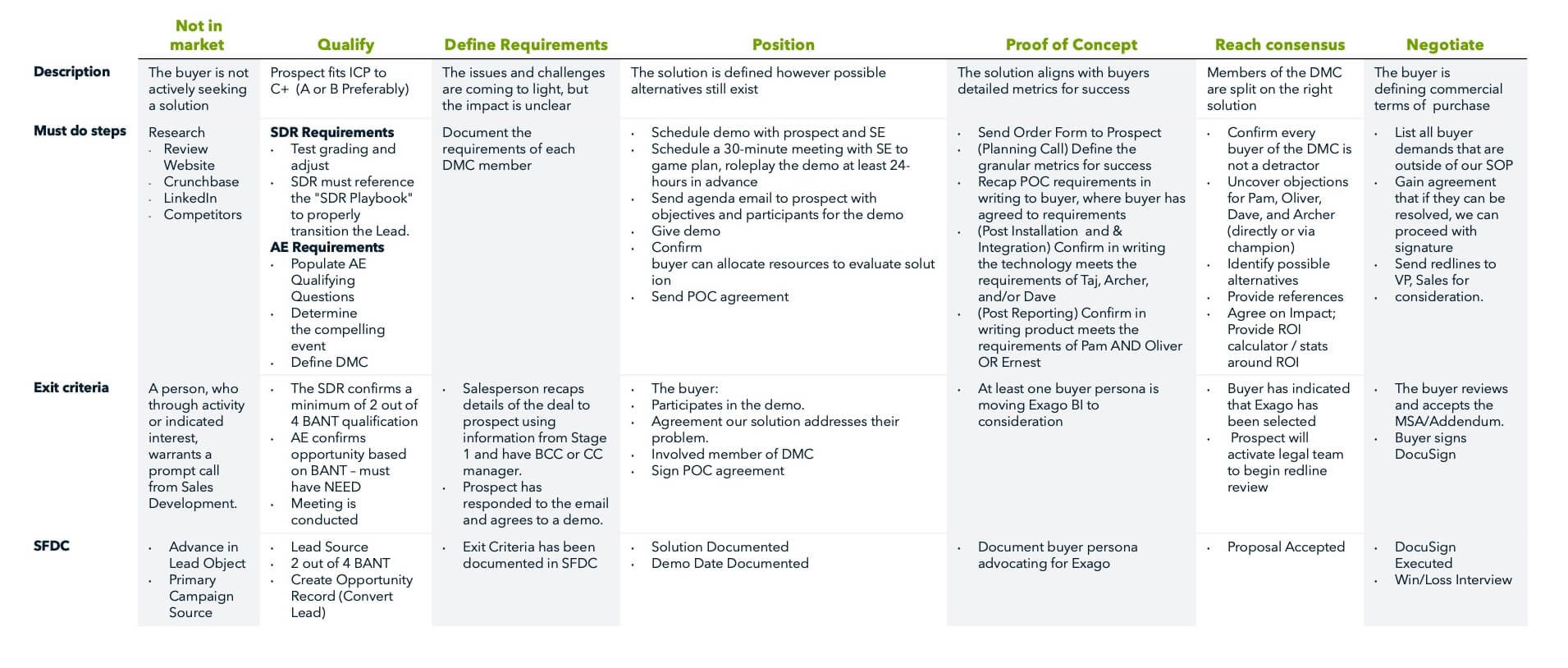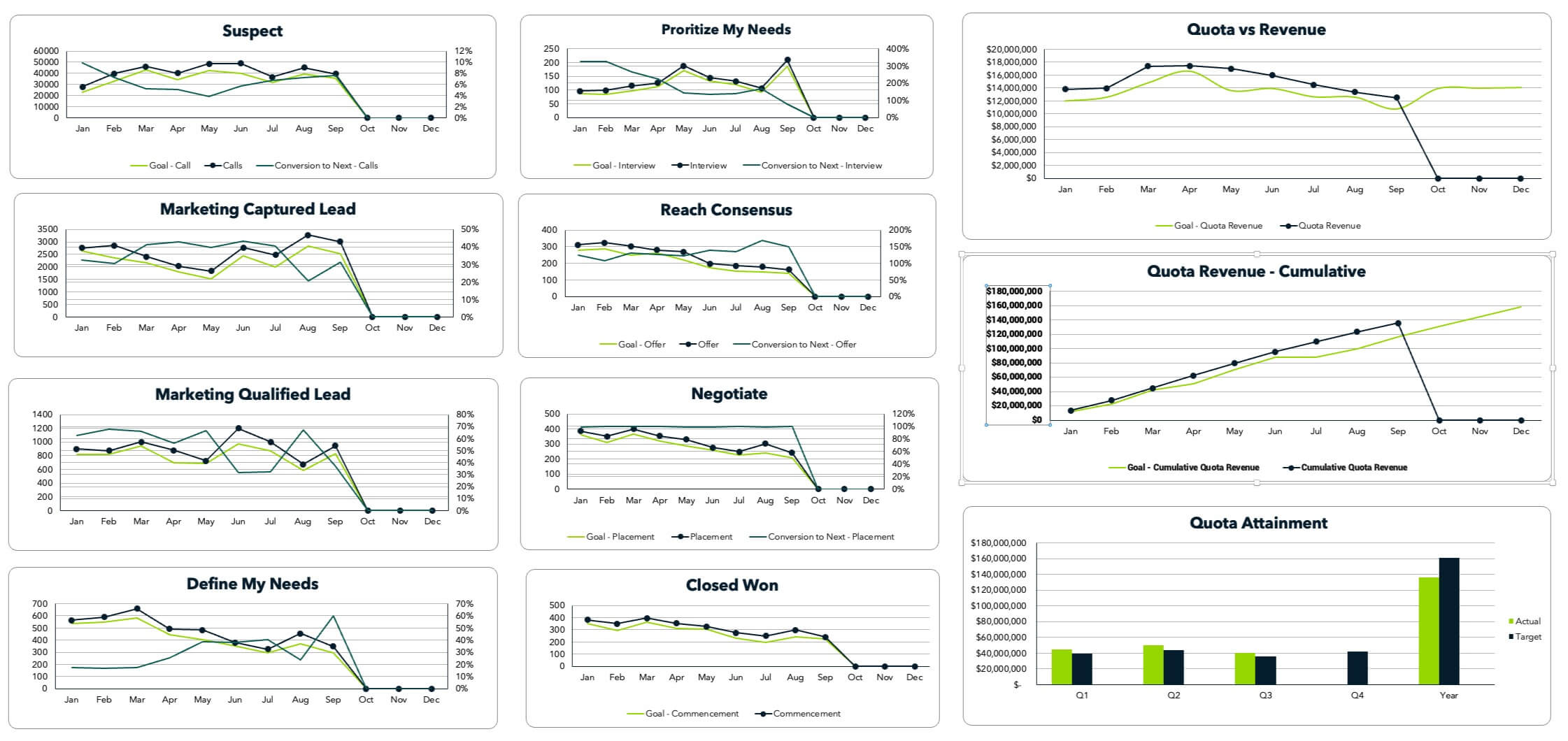During a routine visit to Boston to meet with Michael, a colleague and PE firm Managing Director, we discussed declining revenue performance he’s experiencing with key portfolio companies.
“Forecasts across my portcos are all over the map,” he explained. “One of my portcos is taking twice as long to close fewer deals. And we have no accurate visibility into the pipeline and forecast.”
We started to discuss the four key areas he needs to focus to turn things around.
- Promote Commercial Insight-Driven Targeting
- Decode Purchasing Patterns
- Develop Predictive Forecasting
- Enhance Role Clarity
Key Area 1: Promote Commercial Insight-Driven Targeting
Having the right message at the right time can make or break a deal. To capture what resonates with your audience, it’s crucial for Go-to-Market (GTM) teams to develop a clear ideal customer profile (ICP) and buyer personas. Without this, your team risks wasting time and resources on leads that are not a good fit, intensifying the sales decline you’re working to avoid.
Like any house, the foundation supports the structure, and with GTM, it’s your ICP. Determine at least four factors that make up your best customers. Then gather a panel of experts to assign weights to top factors based on their relative importance. These factors will then provide the framework for the potential spend of your prospect universe.
Often referred to as account segmentation, grade your accounts based on these factors. This will help your GTM teams prioritize their efforts and optimize their strategies. A simple tiered segmentation approach can be effective, such as targeting As and Bs, pursuing Cs optimistically, and scrutinizing Ds.
Once target accounts are identified, we must understand the individual people that form a decision team. Buyer personas are essential tools to represent the diverse individuals in a buying cycle. These will be the basis for all your content and talk tracks. This exercise requires careful consideration of various factors, including:
- Company size
- Industry
- Various job titles
- Pain points
- Buying behaviors
- Emotional states
Ensure thoroughness in your market research by avoiding shortcuts like focusing solely on demographics and firmographics. Consider it a failed exercise if you don’t document the emotional and organizational factors that influence buyers. Interview your customers, your leaders, and front-line team members to capture these emotions. These insights will ultimately drive the messaging for your GTM team. Once you’ve equipped your GTM team with this information, your close rate will increase now that the messaging resonates with the buyer.
Regularly review and update these tools, ideally on a quarterly basis. This ensures they remain relevant, reflecting any pivots in your market, customer behavior, and product updates.
Key Area 2: Decode Purchasing Patterns
Brent Adamson, Distinguished VP at Gartner, suggests the buyer’s journey is non-linear, resembling a bowl of spaghetti. While true, all people embark on an emotional journey and then quantify after. Companies that disregard the buyer’s journey suffer high drop-off rates in the sales pipeline.
Instead, align your sales process with customer decisions. Why is this important? This promotes accountability and collaboration, ensuring everyone is on the same page regarding your sales process. I see it too often; the sales rep says they’re ready to buy, only to have the deal die at a late stage.
A well-defined sales process addresses customer pain points at each stage, safeguarding deals from impulsive qualification. You’ll see improved conversion rates, more meaningful conversations in your team, plus accurate forecasts.
Start by mapping out your customer’s journey, from awareness to consideration to decision-making. Interview key members of the cross-functional team, including CEOs, Founders, Sales, Marketing, and Customer Success. I’ve found that Sales Engineers are the diamond in the rough. They are closest to the customer and the buying process to offer accurate, unbiased insights into the journey.
Be sure to capture trigger points, forces that propel your target customer into the market. The combination of personas and trigger points allows your marketing and sales teams to create concrete hypotheses on how they can help specific personas. This is especially important in any outbound motion where the GTM team is cold-calling.
After identifying your target buyers, implement a lead management system to prioritize and nurture leads. Set qualification criteria (BANT, MEDDPICC), create nurturing workflows, and score and re-engage leads based on behavior. This structured approach safeguards bad leads from falling into the sales funnel.
For a healthy sales pipeline, establish a clear opportunity management system. To meet the standards of a high-performing sales team, you must possess the following essential elements:
- Clear stage definitions that align with journey stages
- Must-do steps for each stage
- Clear stage exit criteria to prevent premature stage progression
- Job aids or supporting interaction collateral for reps
By tracking and measuring progress against these standards, you can quickly identify areas of the funnel that are experiencing drop-offs and take action to address the sales decline on a more granular level.
Key Area 3: Develop Predictive Forecasting
Implementing a comprehensive revenue operations strategy helps your sales team remain accountable and ensures they focus on the right metrics. This involves defining and measuring key performance indicators like lead conversion rates, opportunity win rates, and sales cycle lengths. Establish clear goals and targets for each metric, each of which will factor into your strategy to overcome the sales decline.
RevOps is a broad discipline, but I’ll dive into a single aspect of RevOps, funnel metrics. Once you’ve identified your ICP and sales approach, the lowest-hanging fruit is to measure program effectiveness through stage metrics. While this is useful for spotting issues, it is also a great tool for finding areas to exploit.
Start by developing a revenue model that tracks lead progression from top-of-funnel to renewal. Break it down monthly, weekly, or quarterly depending on sales velocity.
The above dashboard lets you monitor performance per stage and track conversion rates (to close and next stage) effectively. It serves as a crystal ball to detect potential underperformance before it’s too late. For instance, a slump in the marketing qualified lead (MQL) stage signals a future impact on deal volume, giving you time to adjust.
Key Area 4: Enhance Role Clarity
Is your Head of Sales building sales reports? Are reps doing the work of marketing, such as building sales decks or enablement material? Are your managers on the front lines doing too much?
When it comes to building a successful GTM team, ensure that everyone is working within their designated roles and responsibilities. It is not uncommon for roles to become corrupted, with team members taking on tasks that fall outside their lanes. Looking busy can lead to inefficiencies and ultimately hurt the success of the team and your numbers. There’s a fine line between rolling your sleeves up to solve a problem and perpetuating behavior that will not scale.
To identify role corruption, conduct rep time studies and analyze leadership activities. These studies assess if reps devote excessive time to non-core tasks like creating sales decks. Leadership activities highlight whether managers spend too much time on the front lines instead of coaching and mentoring. Analyzing both factors helps uncover inefficiencies and address role corruption effectively.To resolve a sales decline, ensure that every team member is working efficiently, first and foremost.
Another important indicator is the outcomes of funnel metrics. If certain metrics are consistently falling short, it could be a sign that the GTM team is functioning outside their lanes and not working effectively together.
To remedy this, clarify roles in job descriptions, ensuring everyone knows their expectations and their teammates. Establish activity metrics and cross-functional oversight for effective collaboration.
Incentive plans should also be adjusted to encourage the right behaviors. For example, team bonuses can be tied to overall team performance rather than individual performance, which can incentivize team members to work together towards a common goal.
If you need to hire, ensure you have a solid hiring playbook. Most commonly, you should have a:
- Talent acquisition plan (including sourcing & recruiting)
- Interviewing process
- External talent assessments
- Job trials
- Onboarding plan by role
Failing to leverage these proven hiring plays increases the risk of a bad hire. Calculate hiring costs ($15k) + training ($20k) + first-year salary ($75k). Then add a rep’s quota, anywhere from $800k – $3M, and you could be making a two-million-dollar mistake. Take the right steps to hire good talent.
Ultimately, addressing role corruption requires a combination of clear communication, accountability, and incentives. By ensuring that everyone is working within their designated roles and responsibilities, your Go-to-Market team can function effectively and achieve greater success.
The Positive Impact of the Four Focus Areas at Exit
The importance of addressing key business fundamentals to counteract a sales decline cannot be overstated. Overlooking sales and marketing alignment, performance metrics, and GTM team control can damage companies and investors.
I assisted a stagnant SaaS company aiming to sell in 12-18 months. Flat sales affected their valuation, resulting in a lower multiple on earnings than the market average. By targeting four key areas, we doubled the win rate and boosted enterprise value. Revenue surged by 38%, attracting multiple offers at a higher multiple of 6:1.
By confronting these challenges proactively and executing a robust revenue-building strategy, you will safeguard a company’s future but also position it favorably for a successful exit. So, to all who believe in commercial excellence out there, don’t underestimate the impact of focusing on the basics – it could be the difference between a mediocre outcome and a truly outstanding success story.
While I’ve outlined some fundamental aspects of GTM, a comprehensive review lays the foundation for success. Cortado’s proprietary assessment has been instrumental in achieving positive outcomes. By conducting this audit, we can prioritize your efforts and increase the likelihood of achieving favorable results.
Let us give you a hand, schedule your GTM assessment with Cortado Group today, and let us help prioritize your efforts for optimal outcomes.






